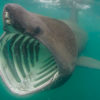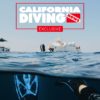There are more than 20 miles of coastline in Malibu, and for divers who live and work in the San Fernando Valley and its northern environs, they represent the only diving possible during the workday when we can’t waste time in L.A. traffic. Fortunately, there are plenty of dive sites to choose from. These Malibu dive sites offer varied reefs, hunting sites, submarine canyons and sometimes easy access. However, many of these locations suffer from pounding surf; but when you gotta get wet, there is a region that provides entry when most of the coast is either undiveable or at least uninviting. It’s “The Slot,” a name we have given it due to its appearance on the Coastal Data Information Program (CDIP) plots of near-shore waveheight (http://cdip.ucsd.edu/models/la_hs.gif). The Slot lies between Malibu Lagoon and Point Dume but the diving is between Corral Beach and Paradise Cove.
The smaller surf in this area is probably due to several geographic features. First, there is the obvious Point Dume that shadows the coast from waves coming from the northwest, the usual swell direction. Santa Catalina Island similarly blocks southeastern swell. However, the Dume submarine canyon also plays a part as it doesn’t refract waves toward the shore, permitting them to propagate harmlessly (for Slot divers) into Santa Monica Bay. The result of this geographical confluence is that the Slot permits easier beach entries than the rest of the Malibu area and nearby coastline.
Fortunately, there is plenty to see in the Slot. The principal dive locations are, from east to west, Corral Beach, Escondido Creek, Geoffrey’s, and Paradise Cove. Corral Beach may be the most popular site. Parking is on PCH at the west side of the beach across from the Beau Rivage restaurant, and the ocean is a short walk down a small hill. The dive entry can be a bit tricky at Corral due to a large number of submerged rocks, but just west of the creek, usually dry, there are far fewer rocks to step over. Dolphins and seals are often seen from the shore, as well as the buoys of lobster traps in season.
There are extensive kelp beds to explore in a low-lying reef that parallels the coast. Lobster can be had at the opening of the season and game fish are relatively plentiful. On PCH, east of the entry path and visible from the water, is a yellow hydrant that is an easy marker for a large, 6-foot tall rock lying directly south at a depth of 25 feet. This rock, lovingly called Ex-Scalloper due to the scallop scars on it, is a good spot to see rockfish that congregate about its base. West of the entry point the kelp forests become thicker and wider, providing more territory for adventure. There are no beach access gates at Corral, so you can dive anytime. Also absent are facilities, but port-o-potties can be found a half-mile east in a parking turnout along PCH.
Escondido Creek is a mile or so to the west of Corral. The reefs are closer to the shore here but provide a similar habitat to that seen at Corral Beach. Lately, Giant Black Sea Bass have been seen at both sites and giant kelpfish are also common. A drawback to Escondido Creek is that there is no parking at the access point that is adjacent to the bridge over the creek. Rather, parking is on PCH farther up the hill, ensuring a small hike from your vehicle to the beach. The beach access gate is never locked and there is a sandy beach entry, making this a popular night diving location. Unfortunately, there are no facilities.
Moving up the hill from Escondido Creek is a signed access point commonly called Geoffrey’s, after the fashionable restaurant next to the access path. The only divers you will see here are your buddies as parking consists of just two spaces on PCH. The access is at the top of a hill so that climbing up the 117 steps (aka, “The Tower”) to your vehicle after a dive may be unpleasant if you do not do this often. Experienced beach divers who hike goat paths find the stairs provided by the Coastal Conservancy very comforting as the handrails provide a margin of safety against falling with gear on. The kelp forest is exceptionally widespread over acres of a small-rock debris field. My personal observation is that the game fish are larger here, perhaps due to the difficult accessibility and the large number of steps. There are no facilities and the gate is locked at night.
The final site in the Slot is Paradise Cove. The kelp is not as extensive as at the eastern sites. Lobsters, mussels and piddock clams abound and visibility can often be very good. The draw here is the close parking, essentially on the beach, and the restaurant. Paradise Cove used to have excellent diver facilities, including restrooms and showers, but the last time I was there these were locked. The drawback is the steep parking fee, $20, that may be waived if you eat at the restaurant, which is worth it. Carpool to offset the parking fee and Paradise Cove warrants a visit.
So when the surf is a bit high, or even when it isn’t, give the dive sites in the Slot a try. Relax with an easy entry and exit and enjoy the myriad of sea life so close to the city.
Editor’s Note: Malibu residents are very protective of their property rights and privacy. The public has access along the beach from the high tide mark and out to sea. Do not intrude above the high tide mark as this would be considered trespassing. Please be quiet and respectful.






